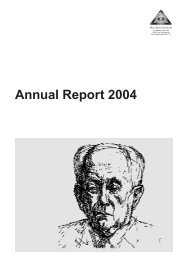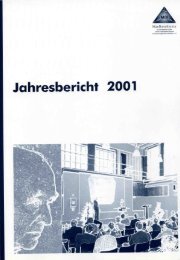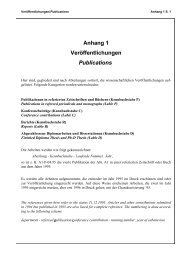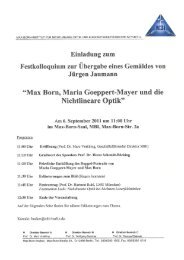You also want an ePaper? Increase the reach of your titles
YUMPU automatically turns print PDFs into web optimized ePapers that Google loves.
interpretation<br />
the Ψ function<br />
On 24 November 1954, Albert Einstein wrote to his friend <strong>Max</strong> <strong>Born</strong>: “I was very pleased to<br />
hear that you have been awarded the Nobel Prize – even though somewhat belatedly – for<br />
your contributions to the present quantum theory. After all, it was particularly your rigorous<br />
statistical interpretation of the description that decisively clarified our thinking. This seems to<br />
me to be quite clearly the case in spite of our inconclusive correspondence on this subject.”<br />
<strong>Born</strong> and Einstein had been close friends since 1913, that is to say roughly since <strong>Born</strong>’s time<br />
in <strong>Berlin</strong>, but – as indicated by Einstein’s allusion in this letter – they had never been able to<br />
agree upon a joint interpretation of quantum theory.<br />
<strong>Born</strong> describes the origin of his idea of a statistical significance of the wave function, for which<br />
he was awarded the Nobel Prize, in his speech of acceptance and in his autobiography. I quote<br />
from the latter: “I was guided here by a remark of Einstein’s about the significance of the<br />
intensity of light (i. e. of an electromagnetic wave) from the aspect of the photon. This intensity<br />
must represent the number of photons, but the latter was, of course, to be regarded statistically<br />
as the mean of a certain photon distribution. Einstein had made some profound considerations<br />
of the statistical nature of this distribution ... I was very familiar with these considerations<br />
and they led me directly to the conjecture that the intensity of the de Broglie wave,<br />
i.e. the square of Schrödinger’s wave equation, had to be regarded as the probability density,<br />
as the probability of a particle being present in a volume unit”.<br />
This is still the approach that we take in physics today. <strong>Born</strong>’s statistical interpretation was also<br />
the starting point for the Copenhagen interpretation of quantum mechanics, which has survived<br />
up to the present day in a variety of forms. Nevertheless, the interpretation of the wave<br />
function even today remains an unsolved physical and above all epistemological problem which<br />
we have carried over in our baggage from the physics of the twentieth century into our work<br />
in the twenty – first century. The collapse and Everitt interpretations are current versions of<br />
these attempts to synchronize our powers of imagination oriented to classical physics with the<br />
concepts of quantum theory.<br />
Einstein was surprised that <strong>Born</strong> received the Nobel Prize so late. In his memoirs, <strong>Born</strong> himself<br />
wrote on the subject: “My statistical interpretation of the Ψ function was merely the first step<br />
in our understanding of the relation between particles and waves in atomic physics. Even if the<br />
vast majority of physicists accepted this interpretation, there were always those for whom this<br />
was not the case including ... Planck, Einstein, de Broglie and Schrödinger, .... This may well<br />
be the explanation of why I only received the Nobel Prize for my work 28 years later”.<br />
<strong>Max</strong> <strong>Born</strong> • Paul Corkum 49












